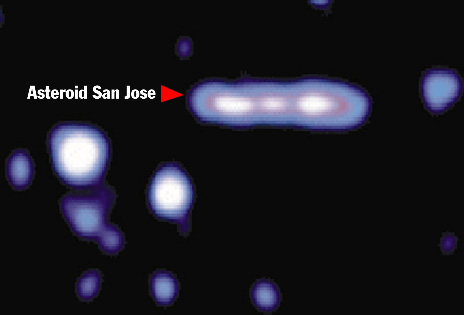![[Currents header graphic]](http://www.ucsc.edu/homeart/currents_header.gif)
![[Currents header graphic]](http://www.ucsc.edu/homeart/currents_header.gif)
May 25, 1998

|
|
Asteroid San Jose, as shown in this photo taken from Lick Observatory
|
By Jim Burns
Representatives of UCSC and Lick Observatory presented the San Jose City Council on Tuesday, May 19, with a commemorative photograph of an asteroid that has been named in honor of the Silicon Valley city.
The naming designation was done to acknowledge the city's longtime efforts to work cooperatively with Lick staff--a partnership that has helped keep the 110-year-old mountaintop facility one of astronomy's most productive observatories.
Observatory staff and the asteroid's discoverer, S.J. Bus, had successfully petitioned the International Astronomical Union to name the asteroid after San Jose.
Presenting a framed digital image of Asteroid San Jose--and an accompanying short essay about the celestial body--to the city council were Chancellor Greenwood and Joseph Miller, director of UC Observatories/Lick Observatory.
In her remarks to the council, the chancellor paid particular tribute to the city's efforts to control the type of light its neighborhoods emit--too much of the wrong kind of light can impair Lick Observatory's ability to capture clear and concise images from the night sky. "We recognize the century-old spirit of collaboration with you, as well as the city's ongoing efforts to keep ambient light-levels low by installing low-pressure sodium streetlights," Chancellor Greenwood said. "Low-light levels have permitted observing from Mount Hamilton to continue at extremely productive levels."
The proclamation she and Miller presented to the council underscored the relationship between the city and observatory: "Located 20 miles to the east at the 4,200-foot summit of Mount Hamilton, Lick Observatory is easily visible from almost any neighborhood or street in San Jose," the proclamation read. "Through the city's understanding and efforts, the whole universe is still visible from Lick Observatory."
San Jose is the 6,216th asteroid to be discovered. Traveling in an orbit between Mars and Jupiter, it is estimated to be 10 to 15 miles across--about the same size as the city of San Jose. Discovered by Bus in September 1975, the asteroid was given the temporary designation "1975 SJ" when its orbit was first computed. It is coincidental that the original designation, the initials of the discover's name, and the initials of the city of San Jose are all "S.J."
A part of the University of California since its inception, Lick Observatory has been affiliated with UC Santa Cruz since 1966. In its glorious history, astronomers at the observatory have made a number of important findings, including the discovery of Jupiter's fifth satellite by Edward Emerson Barnard in the observatory's fourth year of operation, in 1892. Lick astronomers also collaborated with astronauts during a 1969 Moon walk to determine the precise distance between the Earth and the Moon and to confirm that the Moon is gradually moving away from the Earth.
Among more current research being conducted at Lick Observatory is the recent effort by astronomers to detect planets outside our solar system. This headline-making work, using the facility's 120-inch Shane Telescope, is being led by astronomers Geoffrey Marcy and Paul Butler. Marcy, who earned his Ph.D. at UCSC, uses an exquisitely sensitive tool designed by his former adviser, UCSC astronomer Steven Vogt. The instrument, called the Hamilton Spectrograph, unveils tiny "wobbles" in the motions of stars across the sky--hints of the gravitational tuggings of unseen planets.